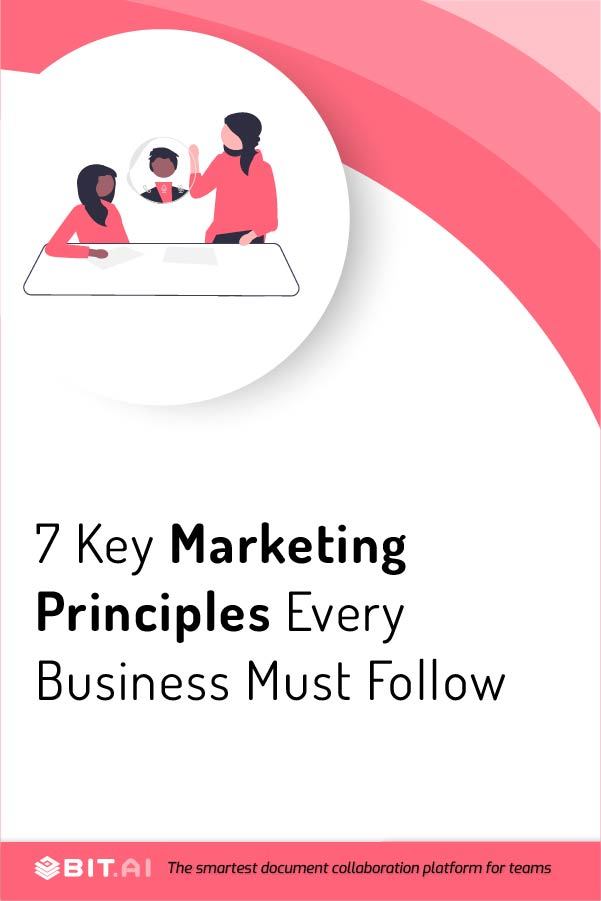Business and marketing go hand-in-hand. Behind every successful business is a stellar marketing plan that works efficiently and helps pave the way to success.
So, if you are contemplating venturing into the world of business, or are already running a business, there is one thing you cannot operate without and that is a marketing strategy.
A marketing strategy is a carefully thought-out plan operating by the principles of marketing. Whether it is an online retailer, a service provider or a street shop, every business has a marketing strategy in place.
Marketing principles are what guide marketing strategies and they are directly linked to the success of any business. This is why marketing principles play such a monumental role in business.
If you want to learn more about marketing principles, why they are important, and what they comprise of, then this is the right place for you! So let’s get started, shall we?
What are Marketing Principles?
Simply put, marketing principles are the principles on which strategies for the promotion of any product are built. They are ideas that are already agreed upon to be effective strategies by companies. Also known as principles of marketing, these principles are used to successfully promote any product, be it goods or services.
We use the term ‘already agreed upon’ because these marketing principles have stood the test of time. They have been around since the 1960’s and have been tried and tested to work. Although some variations do exist here and there, these principles of marketing have been used as a blueprint by businesses for decades.
The 7 principles of marketing are – Product, Price, Promotion, Place, People, Process, and Physical Evidence. Long story short, there were originally 4 marketing principles or ‘4 Ps’ (key elements to focus on) and over time, 3 others were added (with the onslaught of modern digital sales and services). These 7Ps or 7 marketing principles are what guide businesses today.
The Principles of Marketing are the bedrock on which marketing strategies stand. To paint a picture of just how vital these marketing strategies are in the world of business, their importance has been highlighted in the following section!
Why are The 7 Principles of Marketing Important?
1. Provides Guidance
Marketing principles have the largest impact on business direction. The 7 principles are all interconnected with each other and each plays a part in guiding any business forward. In all business endeavors, especially when there is a need to make changes, marketing principles will guide you in visualization and execution.
2. Aids in Product Development
In order to form a marketing strategy, marketing principles require you to conduct extensive research on the said market. Market research equips you with knowledge of what the customer base wants and therefore, aids in product development, pricing, and promotion.
Read More: Product Development Process & it’s 8 Key Stages!
3. Offers Competitor Analysis
It’s a well-known fact that the world of business is competitive. In order to thrive, you have to constantly be one step ahead of your competitors. Marketing principles are important because they help you analyze everything about your competitors, from their strategy of promotion to their pricing, etc.
4. Acts as a Source of Vital Information
The thing about marketing principles is that they not only guide your business, but keep your business informed. As these principles cover every aspect related to business, you will be equipped to deal with any potential obstacle that can arise.
5. Boosts Business Growth
Marketing principles cover every important aspect related to business, from start to finish. Armed with information, direction, and analytical skills, your business is bound to thrive.
 Now that you know the importance of having marketing principles of marketing, let’s go over the 7 Ps of marketing and how to apply them!
Now that you know the importance of having marketing principles of marketing, let’s go over the 7 Ps of marketing and how to apply them!
What Are The 7 Ps of Marketing and How To Apply Them?
1. Product
The first marketing principle is product. A product can be defined as a tangible good or an intangible service that is offered or sold to satisfy customers. So, the term product encompasses a variety of things – it could be a packet of chips or a manicure.
The success of a business is determined largely by sales of products, and in order for a product to sell, there must be a demand. To create demand, several factors come into play. Everything from the design, features, quality, name, etc., all factor in to create a product. So, knowing the entirety of the product cycle is a must in order to guarantee a product will satisfy the customer.
You can check out Bit’s Product launch Marketing template to create a product launch marketing plan for your team and help coordinate a successful product launch.
How To Apply This Principle :
Conducting research on your customer base is first and foremost, the best way to start. This can be done through surveys, interviews, or analysis. This will help you in figuring out whether your product is something that customers will want.
2. Price
The term price basically means the value of a product. It is the actual amount that customers pay for a product or service. Prices can be dependent on a number of direct and indirect factors like cost of production and demand by customers etc.
Price is the second principle of marketing (2nd P) because the price of a product directly correlates with whether customers will buy it or not. It cannot be priced so low that a business suffers a loss, yet it cannot be priced too high either because if the same product is available at a lower price by a competitor, then it results in a loss of sales for your business.
How To Apply This Principle:
Making a decision on pricing can be quite tricky. You have to first factor in the cost of production, the associated costs (including all other costs from labor to advertisement), and the profit margin must also be kept in mind. The best strategy is to first find out the overall estimated costs (even if it cannot be exactly precise), then factor in your profit margin and then decide the appropriate price from thereon.
Read More: What is Price Skimming? Definition, 3 Types of Phases, Pros & Cons!
3. Promotion
Promotion encompasses all the activities involved in getting customers to know about the product or service you are offering. The aim is to not only inform customers, but also garner their interest and persuade them to want to purchase.
Everything from advertisements (on tv, social media, and print media), to content marketing and even word of mouth, can be considered product promotion. The goal is to ultimately convince customers to buy products.
How To Apply This Principle:
In order to promote any product, you have to first identify the target audience and then proceed from there. For any type of promotion, it’s good to cover all bases, i.e., content that provides information as well as something that is eye-catching. It should be both informative as well as appealing. A great tactic of promotion is to make it personal. For example, Spotify offers a personalized feature of a ‘Spotify Wrap’ that customers greatly gravitate towards.
4. Place
Place means the location where your product is available for customers to buy. Place in marketing principles centers around accessibility. In today’s digitalized era, the place does not only mean a physical space, it can also refer to a website or any other online location.
The place also determines the type and quantity of customers. A physical store and an online store will have a difference in sales depending upon the type of product as well as the services offered.

How To Apply This Principle:
The location of a product is one of the biggest factors in sales. No matter how much hype a product promotion garners, if it’s not accessible, then it’s of no use. If the product is to be sold in physical stores, make sure your distributions are in locations where customers can access them easily.
If you are going to sell online, try to diversify and have your products available on at least the major online shopping sites.
5. People
Also known as ‘Positioning’, this marketing principle is crucial because people are what keep businesses going. It is because of people that products are in existence. This principle of marketing encompasses all individuals or persons involved with your product.
People include (but are not limited to) – employees who directly interact with customers such as customer service executives, salespersons, delivery personnel, etc. What this element focuses on is how well these people perform their respective jobs. Another emphasis is to provide the necessary training for them to execute their jobs well.
How To Apply This Principle:
The best way to implement this principle is to improve customer service. For instance, if it is a physical store, the employees (especially the ones interacting directly with customers) should be properly trained to be approachable, helpful, friendly, and insightful so customers feel comfortable. If it is an online store, then quick responses to customer queries, emails, questions, etc., should be emphasized.
One way you can help customers is by creating the right documents to offer them information and navigate them through issues. You can use Bit’s customer service templates to create various documents such as customer service training manuals, instruction manuals, customer service policies, case studies, customer surveys, and more.
Read More: What is Customer Service Policy & How to Create it?
6. Process
Process can be described as a roadmap of sorts for your company’s operations. It is what happens behind the scenes as you create your product or service. From start to finish, anything that impacts or affects how the product is handled can be considered part of the process.
In other words, all the ways in which your company and customers interact before the product reaches them are included in this process.
This process aims to both minimize the cost of your company, as well as maximize benefits for customers. A successful business is one that can attain both.
How To Apply This Principle:
To apply this principle in business, the first step is to optimize the internal processes within your team by streamlining workflow to increase productivity and improve work quality. This will cut costs for your business. Then, the next step would be to analyze the customer’s journey and make the required changes so that satisfaction can be attained.
7. Physical Evidence
Physical evidence consists of anything your customer sees or experiences when interacting with your business. It consists of the tangible aspects of business, the material parts that familiarize your customers with the products or services you are offering that can contribute to purchasing decisions.
For example, if it’s a physical store – the cleanliness, the lighting, the ambiance, etc. If it’s an online website – the design, the aesthetic, etc.
How to apply this principle:
To implement this principle in business is quite simple, anything and everything related to your product that can aid in your customer’s purchasing decision should be kept in mind and maintained in tip-top shape. Pay attention to certain details like packaging, logo, etc., and this will help your product stand out from the rest.
Wrap Up
At the end of the day, a successful business is led by an excellent marketing strategy that focuses on what you want to accomplish with your business.
Though the times have been changing in the world of business and marketing, one that remains the same is the basic principles of marketing. They help you assess and reassess your business and make sure that your business reaches its full potential.
In this blog, we have explained to you the 7 marketing principles and how to apply them. Each principle has its own role to play and they are all linked to each other, in one way or another.
Equipped with this knowledge, you are now one step closer to success. Now all you have to do is put them to use! Good luck, folks!
Further Reads:
How To Create An Effective Marketing Strategy For Your Business?
Marketing Communication Strategy: What is it & How to Create it?
Guerrilla Marketing: What is it and How to Use it For Marketing!
8 Different Types of Branding Strategies (With Examples)
13 Growth Marketing Strategies You Must Know About!
Agile Marketing: Definition, Benefits & Process!
10 Business Drivers to Grow Your Business!
How To Market To Gen Z The Right Way in 2023?


